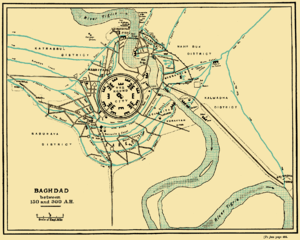Round city of Baghdad

The round city of Baghdad is the original core of Baghdad, built by the Abbasid Caliph al-Mansur in AD 762–767 as the official residence of the Abbasid court. Its official name in Abbasid times was The City of Peace (Arabic: مدينة السلام Madīnat as-Salām). The famous library known as the House of Wisdom was located within its grounds.
On 30 July 762, the caliph Al-Mansur commissioned the construction of the round city, and it was built under the supervision of the Barmakids.[1] Mansur believed that Baghdad was the perfect city to be the capital of the Islamic empire under the Abbasids. Mansur loved the site so much he is quoted saying, "This is indeed the city that I am to found, where I am to live, and where my descendants will reign afterward".[2] The goal was to replace Harran as the seat of the caliphal government; however, a city of Baghdad is mentioned in pre-Islamic texts, including the Talmud,[3] and the Abbasid city was likely built on the site of this earlier settlement.
Baghdad eclipsed Ctesiphon, the capital of the Persian Empire, which was located some 30 km (19 mi) to the southeast, which had been under Muslim control since 637, and which became quickly deserted after the foundation of Baghdad. The site of Babylon, which had been deserted since the 2nd century, lies some 90 km (56 mi) to the south.
The city was designed as a circle about 1 km (0.62 mi) in diameter, leading it to be known as the "Round City". The original design shows a ring of residential and commercial structures along the inside of the city walls, but the final construction added another ring, inside the first.[4] In the center of the city lay the mosque, as well as headquarters for guards. The purpose or use of the remaining space in the center is unknown. The circular design of the city was a direct reflection of the traditional Persian Sasanian urban design. The ancient Sasanian city of Gur/Firouzabad is nearly identical in its general circular design, radiating avenues, and the government buildings and temples at the center of the city.
The roundness points to the fact that it was based on Persian precedents such as Firouzabad in Persia.[5] The two designers who were hired by al-Mansur to plan the city's design were Naubakht, a former Persian Zoroastrian.[6]
References
- ↑ Times History of the World. London: Times Books. 2000.
- ↑ Wiet, Gastron (1971). Baghdad: Metropolis of the Abbasid Caliphate. Univ. of Oklahoma Press.
- ↑ Ket. 7b, Zeb. 9a
- ↑ http://islamicceramics.ashmol.ox.ac.uk/Abbasid/baghdad.htm
- ↑ See:
- Hattstein, Markus; Peter Delius (2000). Islam Art and Architecture. p. 96. ISBN 3-8290-2558-0.
- Encyclopædia Iranica, Columbia University, p.413.
- ↑ Hill, Donald R. (1994). Islamic Science and Engineering. p. 10. ISBN 0-7486-0457-X.
External links
- Al-Mansur's Round City of Baghdad in "archnet" website
- Baghdad (Madinat al-Salam) in "islamic art" website
Coordinates: 33°20′55.68″N 44°20′7.03″E / 33.3488000°N 44.3352861°E